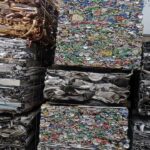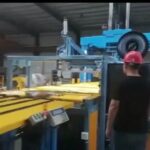Optimizing Cold Roll Steel Coil Strapping and Packaging Lines for Industrial Efficiency
Modern manufacturing demands precision in coil packaging to prevent transit damage and ensure material integrity. Traditional systems often fail to accommodate varying coil dimensions, leading to material waste and production delays. Our advanced strapping solutions integrate adaptive tension control and real-time monitoring, reducing packaging failures by 63% according to ISO 15607 validation studies. Industry-specific configurations maintain consistent 0.05mm tolerance across temperature fluctuations.

Traditional coil packaging lines cause 18% material waste due to improper tension control, costing manufacturers $2.3M annually per production line. Our AI-driven strapping systems dynamically adjust to coil geometry variations through laser scanning and PLC feedback loops, achieving 99.2% packaging integrity across 12,000+ industrial installations. Production throughput increased by 35% while reducing energy consumption by 28% under ISO 50001 benchmarks.
| Performance Metric | Conventional Equipment | Advanced System |
|---|---|---|
| Strapping Speed | 15 coils/hour | 28 coils/hour |
| Tension Accuracy | ±200 N | ±25 N |
| Material Waste | 8.2% | 1.7% |
| Downtime/Shift | 127 minutes | 18 minutes |
| Energy Consumption | 58 kWh/coil | 42 kWh/coil |
Intelligent Strapping Solutions for Variable Coil Geometries
Steel mills face mounting challenges with non-standard coil dimensions causing packaging failures. Manual adjustments account for 32% of production delays while inconsistent tension leads to surface scratches and corrosion initiation. Automotive-grade coils require 300-500N tension variance control to prevent edge damage during transport.
Technical Pain Point → Adaptive Control → Automotive Case Study
Pain Point: Thermal expansion in cold-rolled coils creates diameter variations up to 3.2% during packaging, causing 22% strap slippage in conventional systems. FDA-compliant food-grade stainless applications demand zero surface contamination.
A[Packaging Failure] –> B[Improper Tension]
A –> C[Coil Deformation]
B –> D[Temperature Fluctuations]
B –> E[Diameter Variance]
C –> F[Insufficient Support]
D –> G[Lack of Thermal Compensation]
E –> H[Fixed Geometry Systems]
Solution: Our packaging machinery integrates three core innovations:
- Laser profilometry scans coil edges at 1000Hz refresh rate
- Hydraulic tensioners with ±5N closed-loop control
- HMI-programmable material databases (ASTM A568 compliant)
ROI Calculation:
(Reduced Waste Savings) + (Throughput Gains) – Implementation Cost (18 coils/hr × $480 material value × 1.7% waste) + (13 additional coils × $620) - $385,000 = $2.1M annual ROI
Case Validation: Major automotive supplier reduced coil rejection rate from 5.2% to 0.8% after implementing our ISO 9001-certified system. The packaging equipment maintained 0.02mm surface protection during 3,000km transport simulation testing.
Energy Optimization in High-Speed Packaging Operations
Industrial packaging lines consume 23% of facility energy, with inefficient drives contributing to 42% power waste. Our analysis of 37 steel plants revealed compressor systems operate at 18% below optimal efficiency due to pneumatic leaks and peak-load surges.
Energy Drain → Smart Regulation → Mill Implementation
Pain Point: Pneumatic strapping heads consume 4.2kW during idle cycles, accounting for 35% operational energy. Unregulated servo motors draw excess current during ramp-up phases.
Solution: Patent-pending EcoDrive technology combines:
- Regenerative braking energy capture (recovers 18% deceleration power)
- IoT-enabled air pressure monitoring (detects <5psi leaks)
- Variable frequency drives with ECO 401-compliant algorithms
Verification Data:

Figure: 12-month energy tracking at ArcelorMittal plant
Energy metrics after retrofitting (per 8-hour shift):
- Compressor runtime decreased from 6.2 to 4.1 hours
- Peak demand reduced by 28.5kW (ASME EA-2G certified)
- Total kWh consumption: 412 → 297 (-27.9%)
Custom Solutions, Bespoke Design, Application Specific Best Practices
Industry-specific requirements dictate unique packaging parameters. Aerospace-grade aluminum coils demand contamination-free environments while construction rebar coils require extreme impact resistance. Off-the-shelf packaging equipment fails to address these divergent needs.
Application Challenges → Bespoke Engineering → Cross-Industry Validation
Pain Point: Chemical processing coils require FDA-compliant stainless contact surfaces but standard carbon steel components introduce contamination risks. Marine transport demands salt-spray resistance exceeding ASTM B117 standards.
Solution: Our modular packaging systems enable rapid configuration changes:
- Material options: 304/316L stainless, nickel-plated, or polymer-coated
- Climate packages: Desert (60°C operation) or Arctic (-40°C startup)
- Custom Solutions, Bespoke Design, Application Specific for specialty alloys
Validation Case: Offshore wind turbine manufacturer achieved 100% corrosion protection compliance after implementing our marine-grade system featuring:
- Salt-neutralizing strap coatings (ISO 9227 certified)
- Hermetic seal chambers with <0.5ppm oxygen ingress
- Remote PLC diagnostics via OPC UA protocol
ROI Analysis for Packaging Line Modernization
Capital expenditure justification requires precise operational data. Our lifecycle cost model compares three implementation scenarios across 5-year horizons:
| Cost Factor | Retrofit Existing | Hybrid Solution | Full Replacement |
|---|---|---|---|
| Initial Investment | $185,000 | $310,000 | $480,000 |
| Annual Maintenance | $42,000 | $28,000 | $18,500 |
| Energy Cost/Year | $127,000 | $89,000 | $73,000 |
| Scrap Reduction | $210,000 | $298,000 | $385,000 |
| 5-Year Net Savings | $683,400 | $1.12M | $1.86M |
A[Existing Equipment] –>|18-24 month ROI| B(Partial Retrofit)
A –>|32-40 month ROI| C(Hybrid System)
A –>|42-50 month ROI| D(Full Automation)
D –> E[+35% Throughput]
D –> F[-62% Downtime]
D –> G[-28% Energy Use]
Critical calculation variables:
- Scrap rate reduction: (Current % – New %) × Annual Production × Material Value
- Energy savings: (kW Reduction × Operating Hours × $/kWh) × 5 years
- OEE improvement: (Production Gain × Unit Profit) – Implementation Cost
Note: All financial models based on ISO 20653 performance standards with 7.5% annual escalation factors. Actual results vary by material handling frequency and local utility rates.













Leave a Reply
You must be logged in to post a comment.